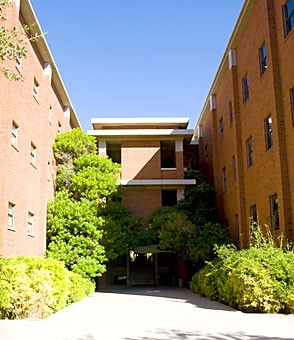If you’re looking for a real reason to skip class, just say the building sucks.
The Richard A. Harvill building, constructed in 1980, is a downright shame to the UA. Harvill was a fine university president and deserving of a building in his honor, but he definitely got the shaft with the worst pile of bricks on campus.
“”HARV”” appearing on your class schedule is the academic equivalent of a punch in the face. Its ultra-confusing entrances, if you can even call them that, lead to gloomy hallways and awkwardly numbered classrooms. Harvill’s lower-level courtyard makes you feel right at home – that is, if you were fortunate enough to post bail.
Not even a conveniently located food cart can save this failure of a building. Many students agree that the Harvill building is the UA’s worst, along with the equally mediocre Modern Languages building with its stairwell of doom.
Thankfully, these buildings are not representative of all architecture on campus. Newer buildings, like the recent Meinel Optical Sciences addition and the Chemical Sciences building, embrace their forefathers while staying innovative and striking. These are the structures that students want to show off to friends and family on campus tours.
Peter Dourlein is associate director of facilities design and construction at the UA, the group that “”oversees the design and construction phases for building, open space and infrastructure projects.”” Essentially, Dourlein helps turn blueprints into reality.
Don’t get out the torches just yet, Dourlein was not around during the design and construction of the Harvill and Modern Languages buildings.
“”I’m not an expert on why (people) don’t like those buildings, but the organizational layout of those buildings are not the best,”” Dourlein said.
“”Not the best”” is quite an understatement, but at least one faculty member doesn’t think Harvill is that bad.
Mark Hickman is an associate professor in the department of civil engineering and engineering mechanics. In his nearly eight years of teaching at the UA, he has had much experience with the Harvill building.
“”I like that it’s convenient to my office,”” Hickman said. “”I actually don’t mind it that much.””
Still, Hickman sees flaws with some of the building’s classrooms. He noted that some of the rooms contain long tables that negatively affect student-teacher interaction.
“”(The tables) make for an adversarial relationship between the lecturer and the class,”” Hickman said. “”They don’t promote face to face discussion.””
I like that it’s convenient to my office, I actually don’t mind it (Harvill) that much.
Mark Hickman, associate professor of civil engineering and engineering mechanics
Obviously, good looks and ease of navigation aren’t the only things that make a good campus building. A classroom’s layout and features can make or break a class. Case in point: Modern Languages’ cramped downstairs rooms are hardly the place to take in an interesting subject.
Compare this to the classrooms of the Manuel Pacheco Integrated Learning Center. From large auditoriums to smaller classrooms, the ILC provides a wide variety of environments that actually encourage you to go to class.
The technologies installed in the ILC auditoriums are top-notch. The rooms are equipped with distance-learning capabilities allowing instructors to connect with other classes across campus or across the country via videoconferencing.
More importantly, these rooms make students comfortable. The desk space is ample and the seating is some of the best on campus. You also have to love the plentiful power outlets: They’re perfect for a mid-lecture YouTube video of a cat on a treadmill.
McClelland Hall offers similar high-end classrooms. Despite its slightly inconvenient location, it might be worth the trek to have a class in the building.
McClelland Hall is “”kind of a dream location to teach”” according to Hickman. Its fancily furnished rooms are undoubtedly impressive.
Currently being constructed along Park Avenue is what looks to be another architectural winner. McClelland Park will be the new home of the John and Doris Norton School of Family and Consumer Sciences.
In addition to functionality and beauty, Facilities Design and Management has its eyes set on “”green”” construction for McClelland Park and other new buildings.
The new structure is being constructed mostly from steel, making it both quick to build and easy on the environment. Steel can be easily reused and recycled, making it a great choice for today’s recycle-focused society.
“”Steel is a very sustainable way to build,”” Dourlein said.
The $22 million project should be completed by late April. The building should be ready for employees and classes by next summer.
The future of campus buildings looks bright. According to Dourlein, architects and designers learn from their mistakes in an attempt to make the best buildings imaginable. Not just local buildings are considered, but projects from across the country are used as case studies as well.
Unfortunately, current students and faculty have to deal with buildings like Harvill and Modern Languages. Ideally, a future generation of Wildcats will have new structures in those locations to utilize.
Perhaps a couple extra Zone 1 lots would hit the spot.









